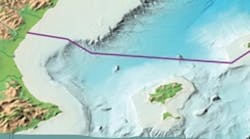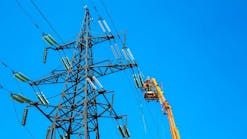The electric supply on the Balearic Islands in the Mediterranean comes from two independent systems. These systems were not linked to the Spanish mainland system, which is connected to the European Network of Transmission System Operators for Electricity (ENSTO-E) system.
To establish a link between the Balearic Islands and the Spanish peninsula, Red Eléctrica de España (REE), the Spanish transmission system operator (TSO), awarded two main turnkey contracts: one to Siemens for converter stations and the other to a consortium formed by Nexans and Prysmian for the cable system. These contracts were the start of the Rómulo project, comprising a high-voltage direct-current (HVDC) submarine cable interconnection between the Spanish peninsula and Mallorca.
The Rómulo Project
The Rómulo project is a 244-km (152-mile) HVDC submarine cable interconnection between the Spanish peninsula in the municipality of Sagunto, Valencia, and the island of Mallorca at Santa Ponsa in the municipality of Calviá. The Rómulo project has several features that make it outstanding and challenging:
-
It is the largest investment made by the Spanish TSO for a single project.
-
It is the world's second-deepest submarine cable system, with a maximum sea depth of 1,485 m (4,872 ft).
-
It is the first HVDC link in the Spanish transmission system.
The configuration of the link is a bipole with metallic return, designed for a bidirectional continuous power-transfer capability of 2 × 200 MW at a rated voltage of ±250 kVdc. The three cable-laying operations occurred in the first half of 2011, and the link became operational in 2012.
The main motivations for the interconnection were to improve the quality and reliability of supply by connecting the Balearic Islands to the Iberian electric market and to reduce overall generation costs in the Spanish electric system. Furthermore, it would reinforce the existing systems in these islands to supply increasing demand.
The Cable System
The cable system comprises the design, testing, manufacturing and installation of the following:
-
Two 237-km (147-mile) HVDC (250-kV) submarine cables
-
Two 7-km (4-mile) HVDC (250-kV) land cables
-
One 237-km medium-voltage return submarine cable
-
One 7-km medium-voltage return land cable
-
One 244-km fiber-optic submarine and land cable.
A main feature of the cable system, each of the submarine cables was loaded onto the cable-laying vessel and installed in one continuous length, thus avoiding the need for joints.
During the feasibility studies, a comprehensive marine route survey was undertaken with two objectives: to select the best routes for the cables between the converter stations on the Spanish peninsula and in Mallorca, and to identify the seabed morphology required to design general protection measures for the cable.
An unusual feature of this project is the use of two mass-impregnated HVDC cables with 750-sq mm (1.16-sq in) copper conductors provided with two different armor designs. Single-flat armor wires are used for the medium/low-water sections of up to 200-m to 220-m (656-ft to 722-ft) water depth and double-flat armor wires are used for the deep-water section up to the extreme maximum water depth of 1,485 m. This approach did not require the use of a transition joint between the two sections.
The insulation is made of high-density paper tapes that provide a high level of electrical performance. The lapping phase is carried out in a controlled environment, controlling both the temperature and humidity. This manufacturing procedure ensures the best quality of the dielectric, avoiding the possibility of wrinkles during the next manufacturing phases when the cable is repeatedly wound and unwound. Drying and impregnating phases are carried out on each manufactured length in a rotating vessel. After the drying phase, the cable is impregnated under pressure with degasified impregnating compound.
The armor is made of two layers of high-mechanical-strength galvanized-steel-shaped wires. The two layers are applied in opposite directions in such a way so as to have no torsion caused by the high tension. Prysmian and Nexans performed sea trials for the high- and medium-water-depth sections using the HVDC cables designed by each manufacturer.
The manufacturing of the 240-km (149-mile)-long submarine cables required almost two years of production time. After factory testing, each pole of HVDC submarine cable was loaded in one continuous length on the cable-laying vessel.
Cable Protection
In the Mediterranean, the trawling gears of fishing vessels and vessel anchors are the main damage hazards for submarine cables. This HVDC interconnection is important for the security of power supply in Mallorca, therefore, the submarine cables were buried from the landfalls at each end down to a water depth of 1,000 m (3,281 ft) to limit the risk of failure from external damage.
Overall, this has resulted in 100 km (62 miles) of each of the three cables requiring protection, a total protected length of 300 km (186 miles). Some 90% of the protection was achieved by high-pressure water injection during installation, allowing up to 2 m (7 ft) of effective sand cover. The remaining 10% of length was protected by post-lay trenching.
The Converter Stations
The converter stations on the Spanish mainland and Mallorca are designed to accommodate four operation scenarios:
-
Bipolar operation mode (with return cable in service)
-
Rigid bipolar operation mode (without return cable in service)
-
Monopolar operation with metallic return using electrode cable
-
Monopolar operation with metallic return using pole cable.
The transfer between the various operating modes of the HVDC — bipolar with and without metallic return, and monopolar with one or two metallic return cables — is covered by automatic control mechanisms. Specific equipment such as a metallic return transfer breaker and a metallic return switch are implemented in the HVDC system and are capable of switching from electrode cable return to pole cable return without any reduction of the power-transfer level or interruption of the dc transmission.
To provide the best voltage support and to balance the reactive power demand of the dc converter at all operating conditions and at least at maximum ac voltage, a total reactive compensation of 200 MVAR are installed at the Morvedre Converter Station and 164 MVAR at Santa Ponsa Converter Station, respectively (referred to nominal ac voltage). The compensation is subdivided into two filter banks of 100 MVAR (one per pole) on the mainland side and four filter banks of 41 MVAR (two per pole) on the Mallorca side of the link.
The operation of a HVDC converter inherently generates harmonic currents, which, if left unaddressed, may propagate into the transmission system and may be amplified because of system resonances. To mitigate these harmonic effects on the mainland side, two passive ac filters of the same design were applied and tuned to the 12th and 24th harmonic.
The Mallorca transmission system may show low-order resonance conditions, thus requiring an additional tuning to the 3rd harmonic, resulting in four identical passive triple-tuned ac filters. Such filter design satisfies the harmonic performance requirements over the whole range of operation and also offers a high degree of flexibility and filter redundancy.
The converters of the Rómulo project are based on 4-inch (101.6-mm) direct-light-triggered thyristor technology. The thyristor valves are arranged in three towers per 12-pulse bridge, each representing one phase. Every tower consists of six modular units, each including 24 series-connected thyristor levels with auxiliary components.
For the Rómulo project, the decision was made to use gas-insulated switchgear technology at the Santa Ponsa (Mallorca) site and high-voltage-insulated switchgear technology at the Morvedre (mainland) site. The selected technologies for the construction of the ac switchyards are the most effective solutions in terms of maintenance and a space-saving layout.
Challenges, Constraints and Results
The Rómulo project encountered three main groups of challenges:
-
Management issues such as two type-test programs, two sea trials, the coordination of two manufacturers at four premises, and social and environmental acceptance concerns
-
Operational issues such as three cable-laying campaigns, off-shore laying at almost 1,500-m (4,922-ft) water depth, long protection campaigns (300 km [186 miles] of burial), landing works (under beach and breakwater intervention) and laying vessels very close to operational limits
-
Engineering issues such as a deep cable design, one-length submarine cable design without intermediate joints, route design and burial assessment.
Different measures were introduced throughout the entire Rómulo project timetable to maximize both environmental integration and social acceptance. This kind of special project is only successful if these two key issues are taken into consideration from the start of the feasibility studies to the final on-site installation operations.
For cable routes, it is extremely important, especially in land and shore approaches, to secure consensus of the proposed alternative with all stakeholders and proper justification of its convenience against the non-selected options at an early stage in the project.
For the converter stations, the most favorable measure was the selection of the indoor design for all the main equipment (except for the transformers). Among the advantages of indoor installation was reduced visual impact with the surrounding industrial buildings and mitigation of noise generated from the filter equipment. The in-house installation of electrical equipment resulted in the homogenous external appearance of the entire converter station.
The most significant efforts in acceptance and integration were made on the Mallorca side of the project because of its special social and environmental conditions. In Santa Ponsa, the visual impact was reduced even more with the selection of earth building colors, imposed by the municipality standards. This tonality integrates the building in the color composition of the farm land adjacent to the industrial area. Moreover, a landscape integration project was developed as a measure to reduce the visual impact of the station even more.
Finally, for the landing point of the submarine cables in Mallorca, a solution based on the horizontal directional drilling technique was adopted. This solution minimized the impact of the works in the Posidonia area and on the beach of Santa Ponsa, both considered very environmentally and socially sensitive.
The Rómulo project establishes a new level of reliability and power frequency control in the Balearic electricity system, reducing power outages and providing a high operational flexibility.
Ramón Granadino Goenechea ([email protected]) was awarded a degree in industrial engineering in 1990 from the Polytechnic University of Madrid, Spain, and a master's degree in electrical and computer engineering from the University of Massachusetts at Amherst, U.S., in 1993. Since 1994, he has worked for Red Eléctrica de España managing projects for the development of the Spanish 220-kV and 400-kV transmission system. Currently, Granadino is director of REE in the Balearic electric system and project manager for the HVDC submarine interconnection between the Spanish peninsular and Mallorca. Additionally, Granadino has been project manager for the submarine interconnection between Spain and Morocco and the undergrounding of a 400-kV double-circuit transmission line at Madrid Barajas Airport using cross-linked polyethylene-insulated cables 13 km (8 miles) in length.
Juan Prieto Monterrubio ([email protected]), who was awarded a degree in industrial engineering by the ICAI University in Madrid, Spain, has spent his entire professional career at Red Eléctrica de España. Prieto started in the transmission line engineering department progressing to the position of project manager of major submarine interconnections, extra-high-voltage transmission lines and substation projects. He is a member of several international technical working groups and has been the secretary of the CIGRÉ Spanish National Committee.
Main features of the submarine double-wire armored cable components for deep-water sections (dimensions indicative)
- The conductor consists of a circular center conductor and concentric layers of keystone-shaped wires of copper
- Diameter of conductor
- The conductor is screened with carbon black paper tapes
- The insulation consists of water-washed wood pulp HVDC cable paper, impregnated with high-viscosity compound
- Nominal thickness
- Diameter over insulation
57 mm (2.2 in)
- Nominal thickness — the sheathing material is extruded lead alloy
- Nominal thickness — extruded sheath of polyethylene
- The transversal reinforcement consists of two layers of galvanized-steel tape
- Shape and dimension of armor wires
- Polypropylene strings — indicative of thickness
Companies mentioned:
ENSTO-E | www.entsoe.eu
Nexans | www.nexans.com
Prysmian | www.prysmianus.com
Red Eléctrica de España | www.ree.es
Siemens | www.siemens.com


